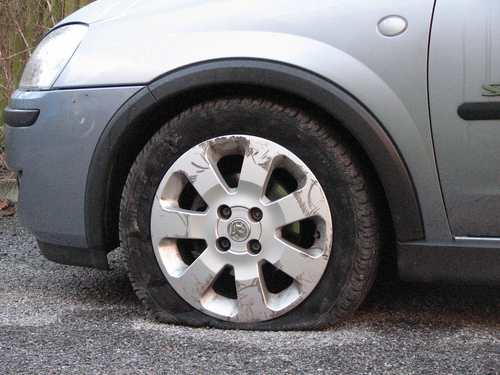
Not a lot of people know that you don’t always need to replace your flat tire. These days, there are actually some pretty neat methods to fix a flat tire and get it to last another 20,000 miles – or however much tread life is left.
If you want an idea of what to expect before you take your car in to the auto mechanic, here are a few things to look at when deciding what to do with your flat tire.
- Identify what caused the flat. If your tire’s experienced some sort of blunt force trauma, like striking a curb by accident or hitting something large at freeway speeds, the likelihood is that there won’t be much of the tire left to salvage. But sometimes, flat tires can come about from pinprick holes caused by nails and other sharp objects that could be a simple fix.
- Next, take a look at what part of your tire’s been affected. Minor damage that occurs on the tread of your tire can be easily fixed as long as it’s not too close to the sidewall. But if you see a nail or other object sticking out of the side of your tire, consider it a goner. Although some auto repair shops might be willing to put a plug in the sidewall of your tire, this is very unsafe and can cause a blowout at higher speeds. In fact, there are laws in place that state if the damage to your tire is too close to the sidewall, it can’t be legally fixed.
- What does the tread of your tire look like? If your tires are running low on tread or are already bald, you’re probably going to have a hard time finding a repair shop willing to patch or plug it. The reason? Fixing a tire that close or that far beyond its usefulness can be dangerous and is another factor that can lead to blowouts. Play it safe. If your tires are bald or almost there, it’s better to replace them than to try to fix them.
- Most flat tires that are repairable can be fixed using one of two methods: a plug or a patch. But which method is better? Some professional tire fixers will swear by one method over the other – but the universally accepted rule is that patches, which are done on the inside, are far better at keeping your tire safely repaired than plugs, which are usually inserted from the outside of the tire. Since patch jobs require your tire to be removed from the rim, this gives a mechanic a better opportunity to take a look at the damage from the inside.
Whenever possible, never drive on a flat tire. This is a sure-fire way of ruining a tire that could have otherwise been easily repaired. When you drive on a flat tire, you weaken the sidewall and can cause irreparable damage. For this reason, it’s always smart to keep a fully inflated spare tire in your trunk and to learn how to change it. Learning how to do this has the potential of saving your hundreds of dollars you’d otherwise spend on a new set of tires, since most auto repair shops strongly recommend replacing two tires at a time
